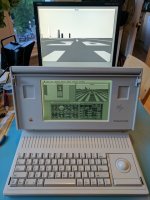stepleton
Well-known member
Hi folks, check this out:

That's a Mac Portable driving an external 800x600 SuperVGA display in addition to its 640x400 LCD. It's no trick---Flight Simulator 4 is putting windows on both displays. (Yes, it's Woz's autograph too but that's not important right now.) The secret is this board that was sitting in the PDS slot when a friend salvaged the machine from a university storage closet in 1999:

That's a "VideoMacPac" external display card made by a company called Computer Care Inc. We think this company is long gone now, but if you want a VideoMacPac of your own, it's easier than you might think! My friend Andrew (you'll know him on the forum as apm) was so interested in the device that he:
Hats off to Andrew for figuring this stuff out---it was fun to watch and to be the rubberduck now and then. Let us know if you make one of your own!

That's a Mac Portable driving an external 800x600 SuperVGA display in addition to its 640x400 LCD. It's no trick---Flight Simulator 4 is putting windows on both displays. (Yes, it's Woz's autograph too but that's not important right now.) The secret is this board that was sitting in the PDS slot when a friend salvaged the machine from a university storage closet in 1999:

That's a "VideoMacPac" external display card made by a company called Computer Care Inc. We think this company is long gone now, but if you want a VideoMacPac of your own, it's easier than you might think! My friend Andrew (you'll know him on the forum as apm) was so interested in the device that he:
- Reverse engineered the connector on the board and made a VGA adaptor for it. This was really cool because up until now the card had been dead weight inside the computer. I knew what it was because the machine had a control panel for it already installed, but Andrew worked out the interlock built into the adaptor that actually turns the thing on. Then he:
- Beeped out the board and duplicated the whole thing, substituting modern components for a couple unavailable old ones. See how there's no ROM on the board? The control panel downloads the CPLD firmware to the card on boot, so there's nothing more to the card than the circuit itself. Andrew dubbed his replacement the "VideoMacPacHack". That's where things stayed for a while, but now:
- he's put everything up on GitHub! (https://github.com/apmcpherson/VideoMacPacHack) The layout, the BOM, all that you need is there to make your own. Plus there's some really detailed technical writeups about how the thing works, which makes for good reading.
Hats off to Andrew for figuring this stuff out---it was fun to watch and to be the rubberduck now and then. Let us know if you make one of your own!
Last edited by a moderator:
